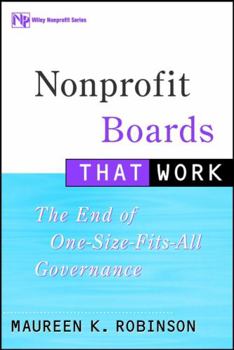Nonprofit Boards That Work: The End of One-Size-Fits-All Governance
Select Format
Select Condition 
Book Overview
Praise for Nonprofit Boards That Work "This book offers a refreshing and candid look at the challenges ofnonprofit boards. It moves away from theoretical frameworks to takeyou inside the real world of nonprofit organizations. . . . A mustfor any executive director who needs reassurance that buildingeffective boards is tough work, but well worth the effort."-SherryRockey, Executive Director, International Women's MediaFoundation "Maureen...
Format:Hardcover
Language:English
ISBN:0471354325
ISBN13:9780471354321
Release Date:January 2000
Publisher:Wiley
Length:176 Pages
Weight:0.96 lbs.
Dimensions:0.7" x 6.3" x 9.3"
Customer Reviews
2 ratings
Excellent resource
Published by Thriftbooks.com User , 22 years ago
This is a very practical, common-sense book. It is very obvious that the author has a lot of experience with what works (and doesn't work!) in the real world. If you serve on a nonprofit board, or are considering doing so, I very strongly urge you to read it.
Don't Put Your Trust In One Governance Model
Published by Thriftbooks.com User , 22 years ago
Since the publication of John Carver's "Boards that Make a Difference" in 1990, much of the literature about nonprofit boards has been directed to supporting or debunking Carver's presentation of a universal governance model. The subtitle of Maureen Robinson's recent book (the end of one-size-fits-all governance) advises the reader of this author's point of view that whatever their similarities, nonprofits differ dramatically in terms of scale and structure, organizational history and cultural traditions. "A million nonprofits will arrive at almost as many variations in strategies for achieving good governance" she writes. "Each Board must fit its performance to the needs of the organization it serves and be willing to change as the organization changes." Particularly useful in this context is Robinson's differentiation of the board's role into three "dimensions:" legal, functional, and symbolic. The legal dimension represents the board's fiduciary role and its stewardship duties. The functional dimension is the board's role in managing and delivering the organization's programs and services. The third dimension is the board's symbolic role as an exemplar of the values and culture of the organization.Thankfully, the author also sets out to correct any misapprehensions that governing a nonprofit organization is easy. While the theory of governance may be simple to grasp, implementation is difficult no matter what the size of the organization. Although the board is referred to as a unit, she explains, it is actually a collection of individuals with their own unique reasons for being on the board and their own individual strengths and limitations. Quoting Cyril Houle, she concludes that "a good board is a victory, not a gift."In the early chapters, the author discusses the value and roles of the board, and suggests strategies for managing meetings and structuring committees so that the board can focus on what she considers essential elements of the job of all boards: financial oversight, planning, evaluation, and fundraising.Later chapters address the interpersonal dimensions of board-building: the role of the chairperson, the nature of the relationship with the executive director, recruitment, training and evaluating board members.The author writes in an engaging and personal style with insight and examples from her experience at the National Center for Nonprofit Boards, the Smithsonian Institution, and the American Association of Museums. Interspersed with examples are many suggestions, mostly directed towards chairpersons and executive directors. Addressed to a relatively unsophisticated reader, there is no trivialization of issues, nor condescension. In 176 pages, the book covers its subject quite well. Not to be seen as a manual, it would be useful to anyone in a leadership role in nonprofit organizations. In nonprofit management classrooms, this book would also make an excellent text, presenting an alternative perspective to that of John Carve






